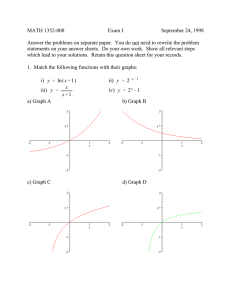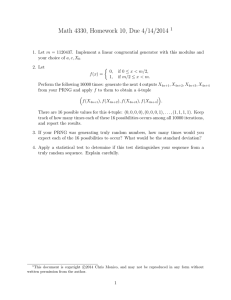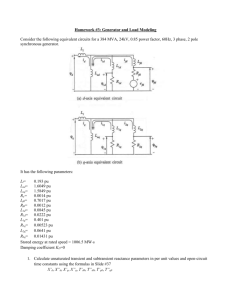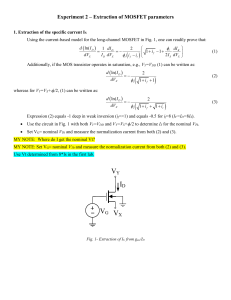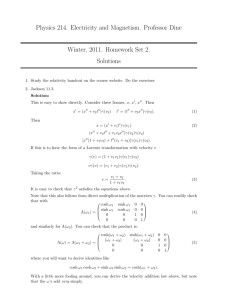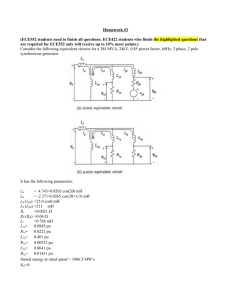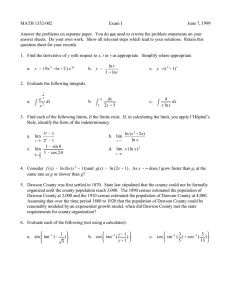ON SOLUTIONS OF THE DIFFERENCE EQUATION x = x /(−1 + x
advertisement
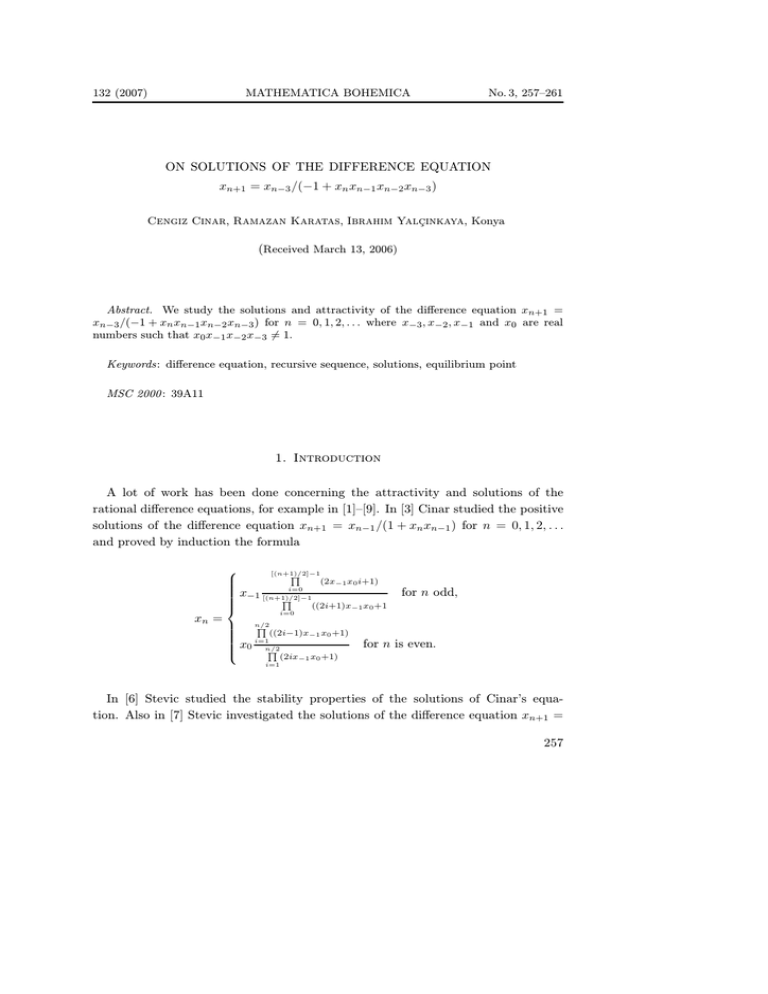
132 (2007)
MATHEMATICA BOHEMICA
No. 3, 257–261
ON SOLUTIONS OF THE DIFFERENCE EQUATION
xn+1 = xn−3 /(−1 + xn xn−1 xn−2 xn−3 )
Cengiz Cinar, Ramazan Karatas, Ibrahim Yalçınkaya, Konya
(Received March 13, 2006)
Abstract. We study the solutions and attractivity of the difference equation xn+1 =
xn−3 /(−1 + xn xn−1 xn−2 xn−3 ) for n = 0, 1, 2, . . . where x−3 , x−2 , x−1 and x0 are real
numbers such that x0 x−1 x−2 x−3 6= 1.
Keywords: difference equation, recursive sequence, solutions, equilibrium point
MSC 2000 : 39A11
1. Introduction
A lot of work has been done concerning the attractivity and solutions of the
rational difference equations, for example in [1]–[9]. In [3] Cinar studied the positive
solutions of the difference equation xn+1 = xn−1 /(1 + xn xn−1 ) for n = 0, 1, 2, . . .
and proved by induction the formula
xn =
[(n+1)/2]−1
Q
(2x−1 x0 i+1)
i=0
x
−1
[(n+1)/2]−1
Q
((2i+1)x−1 x0 +1
for n odd,
i=0
n/2
Q
((2i−1)x−1 x0 +1)
i=1
x0 n/2
Q
(2ix x +1)
i=1
−1
for n is even.
0
In [6] Stevic studied the stability properties of the solutions of Cinar’s equation. Also in [7] Stevic investigated the solutions of the difference equation xn+1 =
257
Bxn−1 /B + xn and gave the formulas
n 2j−1
Y
X
x2n = x0 1 − x1
j=1 i=1
x2n+1
= x−1 1 −
1
,
1 + xi
n 2j
x0 X Y 1
.
1 + x0 j=0 i=1 1 + xi
Moreover, in [1] Aloqeili generalized the results from [3], [6] to the k th order
case and investigated the solutions, stability character and semicycle behavior of the
difference equation xn+1 = xn−k /(A + xn−k xn ) where x−k , . . . , x0 > 0 and A > 0, k
being any positive integer.
Our aim in this paper is to investigate the solutions of the difference equation
(1.1)
xn+1 =
xn−3
−1 + xn xn−1 xn−2 xn−3
for
n = 0, 1, 2, . . .
where x−3 , x−2 , x−1 and x0 are real numbers such that x0 x−1 x−2 x−3 6= 1.
First, we give two definitions which will be useful in our investigation of the behavior of solutions of Eq. (1.1).
Definition 1. Let I be an interval of real numbers and let f : I 4 → I be a
continuously differentiable function. Then for every x−i ∈ I, i = 0, 1, 2, 3, the
difference equation xn+1 = f (xn , xn−1 , xn−2 , xn−3 ), n = 0, 1, 2, . . ., has a unique
∞
solution {xn }n=−3 .
Definition 2. The equilibrium point x̄ of the equation xn+1 = f (xn , xn−1 , . . . ,
xn−k ), n = 0, 1, 2, . . . , is the point that satisfies the condition x̄ = f (x̄, . . . , x̄).
2. Main results
∞
Theorem 1. Assume that x0 x−1 x−2 x−3 6= 1 and let {xn }n=−3 be a solution of
Eq. (1.1). Then for n = 0, 1, 2, . . . all solutions of Eq. (1.1) are of the form
(2.1)
n+1
x4n+1 = x−3 / (−1 + x0 x−1 x−2 x−3 )
n+1
(2.2)
x4n+2 = x−2 (−1 + x0 x−1 x−2 x−3 )
(2.3)
x4n+3 = x−1 /(−1 + x0 x−1 x−2 x−3 )n+1 ,
(2.4)
x4n+4 = x0 (−1 + x0 x−1 x−2 x−3 )
n+1
,
,
.
P r o o f. x1 , x2 , x3 and x4 are clear from Eq. (1.1). Also, for n = 1 the result
holds. Now suppose that n > 1 and our assumption holds for (n − 1). We shall show
258
that the result holds for n. From our assumption for (n − 1) we have
n
x4n−3 = x−3 / (−1 + x0 x−1 x−2 x−3 ) ,
x4n−2 = x−2 (−1 + x0 x−1 x−2 x−3 )n ,
n
x4n−1 = x−1 / (−1 + x0 x−1 x−2 x−3 ) ,
n
x4n = x0 (−1 + x0 x−1 x−2 x−3 ) .
Then, from Eq. (1.1) and the above equality, we have
x4n+1 = x4n−3 /(−1 + x4n x4n−1 x4n−2 x4n−3 )
x−3 / (−1 + x0 x−1 x−2 x−3 )n
x−3
=
=
n+1 .
−1 + x0 x−1 x−2 x−3
(−1 + x0 x−1 x−2 x−3 )
That is,
x4n+1 =
x−3
n+1 .
(−1 + x0 x−1 x−2 x−3 )
Also,
x4n−2
−1 + x4n+1 x4n x4n−1 x4n−2
x−2 (−1 + x0 x−1 x−2 x−3 )n
=
−1 + x0 x−1 x−2 x−3 /(−1 + x0 x−1 x−2 x−3 )
x4n+2 =
n+1
= x−2 (−1 + x0 x−1 x−2 x−3 )
.
Hence, we have
x4n+2 = x−2 (−1 + x0 x−1 x−2 x−3 )
n+1
.
Similarly,
n
x4n+3 =
x−1 / (−1 + x0 x−1 x−2 x−3 )
x4n−1
=
−1 + x4n+2 x4n+1 x4n x4n−1
−1 + x0 x−1 x−2 x−3
x−1
=
n+1 .
(−1 + x0 x−1 x−2 x−3 )
Consequently, we have
x4n+3 =
x−1
n+1 .
(−1 + x0 x−1 x−2 x−3 )
Now we prove the last formula. Since
x4n
−1 + x4n+3 x4n+2 x4n+1 x4n
n
x0 (−1 + x0 x−1 x−2 x−3 )
=
−1 + x0 x−1 x−2 x−3 /(−1 + x0 x−1 x−2 x−3 )
x4n+4 =
= x0 (−1 + x0 x−1 x−2 x−3 )n+1 ,
259
we have
x4n+4 = x0 (−1 + x0 x−1 x−2 x−3 )
n+1
.
Thus, we have proved (2.1), (2.2), (2.3) and (2.4).
Theorem 2. Eq. (1.1) has three equilibrium points which are 0,
√
√
4
2 and − 4 2.
P r o o f. For the equilibrium points of Eq. (1.1) we write
x̄ = x̄/(−1 + x̄x̄x̄x̄).
Then we have
x̄5 − 2x̄ = 0.
Thus, the equilibrium points of Eq. (1.1) are 0,
√
√
4
2 and − 4 2.
Corollary 1. Let {xn } be a solution of Eq. (1.1). Assume that x−3 , x−2 , x−1 ,
x0 > 0 and x−3 x−2 x−1 x0 > 1. Then all solutions of Eq. (1.1) are positive.
P r o o f. This is clear from Eqs. (2.1), (2.2), (2.3) and (2.4).
Corollary 2. Let {xn } be a solution of Eq. (1.1). Assume that x−3 , x−2 , x−1 ,
x0 < 0 and x−3 x−2 x−1 x0 > 1. Then all solutions of Eq. (1.1) are negative.
P r o o f. This is clear from Eqs. (2.1), (2.2), (2.3) and (2.4).
Corollary 3. Let {xn } be a solution of Eq. (1.1). Assume that x−3 , x−2 , x−1 ,
x0 > 0 and x−3 x−2 x−1 x0 > 2. Then
lim x4n+1 = 0, lim x4n+2 = ∞, lim x4n+3 = 0 and lim x4n+4 = ∞.
n→∞
n→∞
n→∞
n→∞
P r o o f. Let x−3 , x−2 , x−1 , x0 > 0 and x−3 x−2 x−1 x0 > 2.
Then x−3 x−2 x−1 x0 − 1 > 1 and Eq. (2.1), (2.2), (2.3) and (2.4) imply
lim x4n+1 = lim
n→∞
n→∞
x−3
= 0,
(−1 + x0 x−1 x−2 x−3 )n+1
lim x4n+2 = lim x−2 (−1 + x0 x−1 x−2 x−3 )n+1 = ∞,
n→∞
n→∞
lim x4n+3 = lim
n→∞
n→∞
x−1
= 0,
(−1 + x0 x−1 x−2 x−3 )n+1
lim x4n+4 = lim x0 (−1 + x0 x−1 x−2 x−3 )n+1 = ∞.
n→∞
n→∞
260
Corollary 4. Let {xn } be a solution of Eq. (1.1). Assume that x−3 , x−2 , x−1 ,
x0 < 0 and x−3 x−2 x−1 x0 > 2. Then
lim x4n+1 = 0, lim x4n+2 = −∞, lim x4n+3 = 0 and lim x4n+4 = −∞.
n→∞
n→∞
n→∞
n→∞
The proof is similar to that of Corollary 3. Thus it is omitted.
Now, we give the following result about the product of solutions of Eq. (1.1).
Corollary 5.
s
Q
n=0
x4n+1 x4n+2 x4n+3 x4n+4 = (x0 x−1 x−2 x−3 )s+1 where s ∈ Z+.
P r o o f. From Eqs. (2.1), (2.2), (2.3) and (2.4) we obtain
x−3
n+1
x4n+1 x4n+2 x4n+3 x4n+4 =
n+1 x−2 (−1 + x0 x−1 x−2 x−3 )
(−1 + x0 x−1 x−2 x−3 )
x−1
n+1
×
= x0 x−1 x−2 x−3
n+1 x0 (−1 + x0 x−1 x−2 x−3 )
(−1 + x0 x−1 x−2 x−3 )
and the above equality yields
s
Y
x4n+1 x4n+2 x4n+3 x4n+4 = (x0 x−1 x−2 x−3 )s+1 .
n=0
Thus, the proof is complete.
References
[1] Aloqeili M.: Dynamics of a k th order rational difference equation. Appl. Math. Comput.
(In press.).
[2] Camouzis E., Ladas G., Rodrigues I. W., Northshield S.: The rational recursive sequence
xn+1 = bx2n /1 + x2n−1 . Comput. Math. Appl. 28 (1994), 37–43.
[3] Cinar C.: On the positive solutions of the difference equation xn+1 = xn−1 /(1 + xn
× xn−1 ). Appl. Math. Comput. 150 (2004), 21–24.
[4] Cinar C.: On the positive solutions of the difference equation xn+1 = axn−1 /(1 + bxn
× xn−1 ). Appl. Math. Comput. 156 (2004), 587–590.
[5] Cinar C.: On the difference equation xn+1 = xn−1 /(−1 + xn xn−1 ). Appl. Math. Comput. 158 (2004), 813–816.
[6] Stevic S.: More on a rational recurence relation xn+1 = xn−1 /(1 + xn−1 xn ). Appl.
Math. E-Notes 4 (2004), 80–84.
[7] Stevic S.: On the recursive sequence xn+1 = xn−1 /g(xn ). Taiwanese J. Math. 6 (2002),
405–414.
[8] Stevic S.: On the recursive sequence xn+1 = α + xpn−1 /xpn . J. Appl. Math. Comput. 18
(2005), 229–234.
[9] Yang X., Su W., Chen B., Megson G., Evans D.: On the recursive sequences xn+1 =
axn−1 + bxn−2 /(c + dxn−1 xn−2 ). Appl. Math. Comput. 162 (2005), 1485–1497.
Authors’ addresses: Cengiz Cinar, Ramazan Karatas, Ibrahim Yalçınkaya, Selcuk University, Education Faculty, Mathematics Department, 42099, Meram Yeni Yol, Konya,
Turkiye, e-mail: ccinar25@yahoo.com, rckaratas@yahoo.com, iyalcinkaya1708@yahoo.
com.
261
zbl
zbl
zbl
zbl
zbl
zbl
zbl
zbl
